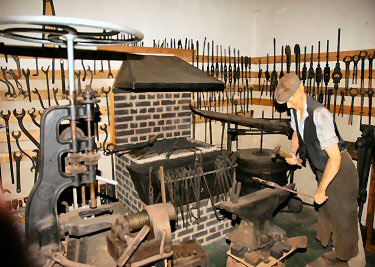

|
For those whose ancestors lived a rural life, it would be reasonable to assume that they would have been employed as agricultural labourers, or in associated trades. All were based on the horse as the main means of power. One such trade was that of the village blacksmith, and his role in the every day life and needs of the village was vital. He would be highly skilled as a farrier, but there was far more to his craft than simply shoeing horses.
Clothed in a leather apron, and working the fire with hand-operated air bellows, the blacksmith would place the metal into the roaring fire to get it hot. When that stage was reached, he would transfer the hot metal from the fire on his long tongs to his anvil, where with his hammer, he would skilfully knock it into the shape of a horseshoe. Then, after dipping the hot metal into cooling trough at the front of the hearth, he would then go to where the horse stood patiently waiting. Then, with his back to the horse, he would pick up the horse's foot, and holding it between his legs he would remove the old shoe. After cleaning the foot he would pare the hoof using a rasp, searcher and pairing knife. He would then offer the new shoe up to the foot, and, once satisfied that the new shoe fitted perfectly, he would nail it in place. The local blacksmith could both make and mend most machinery for local farms and the household. In many cases the iron and steel implements used on the farm had probably been made in the smithy. Farmers would bring their tools to the smithy to be mended, and many smiths were also Farriers and would put horseshoes on the horses. With the horse being the main means of power, there were large numbers of horses at work in the countryside this kept the blacksmith busy. The wheelwright was the skilled man who made cart wheels. With horse-drawn carts and coaches providing most local transport this was an important trade. " He'd do repairs to plough's, disks, and harrows. Farmers would bring up to the shed 3 or 4 spades at a time, to have handles repaired. As a wheelwright, he would repair wagons, virtually anything that could be drawn by animals, including drays and milk vendor's carts. In the days of harsh roads, cart wheels were rimmed in steel, which was forged at the local blacksmith's. The wheel was first dismantled, leaving only the hub, and then completely re-spoked. The wheel would then be dropped into a hole dug in the ground to lie flat. The steel rim was then made up, and dropped into the hole around the wheel while still hot, then could water was poured into the hole to shrink the metal snugly around the wheel, and to stop the wood burning. Village blacksmiths of yesteryear worked long and hard hours, usually for very little pay, and it was quite common to receive payment in kind. His was a craft that was often a family tradition, with skills being passed from father to son. Occasionally he might take on an apprentice, who started by paying his master a small weekly fee, gradually receiving a small wage himself as he became more skilled. Previous Last Edited 03/07/2006 Copyright © 2000-2006 Witheridge Unless otherwise indicated on the page in question, the photographic images reproduced on this site belong to the Witheridge Archives, and, as such may not be reproduced for commercial purposes without written permission. However, you are welcome to use any of the photographs belonging to the archive for personal and/or non-commercial use. Any material shown as not being owned by the archive may not be reproduced in any form without first receiving written permission from the owner of the material in question. The illustration of a Smithy is reproduced with thanks to Tiverton Museum. |


